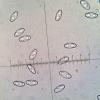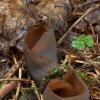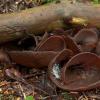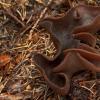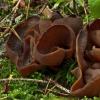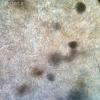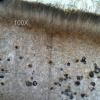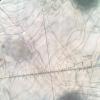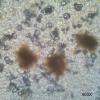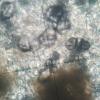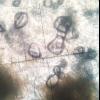
12-11-2025 09:25
 Viktorie Halasu
Viktorie Halasu
Hello, I need help with a pale terrestric Pseudom

11-11-2025 20:16
Bohan JiaHi, lastly I have found these tiny yellow decayin

09-11-2025 13:20
Hello.A tiny ascomycete, appearing as erupting gra

08-11-2025 00:29
 Francois Guay
Francois Guay
I found this species in Quebec, Canada, on herbace
Otidea cf.umbrina
Pavol Palo,
27-08-2014 21:08
what do you think about Otidea cf. umbrina ? I found this one under Picea sp., Alnus glutinosa and Pinus sp..
Fruitbody 30-50 x 20-90 x 20-90 mm
Spores (12)13-16(17) x 6-7 µm
Regards
Pavol
Ibai Olariaga Ibarguren,
29-08-2014 23:10
Re : Otidea cf.umbrina
Hi there!
To me it looks like O. mirabilis as I can see some bluish-violaceous shades in the young ascoma of the first fruitbody. The only other species it can be is O. bufonia, with brown crystal deposits in the medullary excipulum (in water or Melzer). You should check that to rule it out.
At least in Northern Europe O. mirabilis appears to only occur in calcareous localities.
Cheers!
Ibai.
Pavol Palo,
01-09-2014 22:11
Ibai Olariaga Ibarguren,
02-09-2014 09:10
Re : Otidea cf.umbrina
Hi Pavol,
Actually it looks like the medullary excipulum has the sphaeroid brown crystaliized deposits characteritic of O. bufonia. Could you get a photo with the brown crystals in focus?
Cheers!
Ibai.
Actually it looks like the medullary excipulum has the sphaeroid brown crystaliized deposits characteritic of O. bufonia. Could you get a photo with the brown crystals in focus?
Cheers!
Ibai.
Pavol Palo,
02-09-2014 17:28
Ibai Olariaga Ibarguren,
02-09-2014 18:06
Re : Otidea cf.umbrina
Yes, they look like those of O. bufonia. We have also seen O. bufonia specimens with light bluish shades when young and thus reminiscent of O. mirabilis, which seems to be the case. We have never seen sphaeroid crystals like those you have photographed in O. mirabilis.
Thanks!
Ibai.

